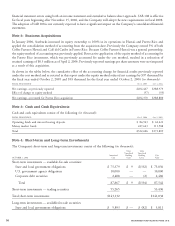Starbucks 2006 Annual Report Download - page 49
Download and view the complete annual report
Please find page 49 of the 2006 Starbucks annual report below. You can navigate through the pages in the report by either clicking on the pages listed below, or by using the keyword search tool below to find specific information within the annual report.Specialty Revenues
Specialty revenues consist primarily of product sales to customers other than through Company-operated retail stores, as
well as royalties and other fees generated from licensing operations. Sales of coffee, tea and related products are generally
recognized upon shipment to customers, depending on contract terms. Shipping charges billed to customers are also
recognized as revenue, and the related shipping costs are included in “Cost of sales including occupancy costs” on the
consolidated statements of earnings.
Specific to retail store licensing arrangements, initial nonrefundable development fees are recognized upon substantial
performance of services for new market business development activities, such as initial business, real estate and store
development planning, as well as providing operational materials and functional training courses for opening new
licensed retail markets. Additional store licensing fees are recognized when new licensed stores are opened. Royalty
revenues based upon a percentage of reported sales and other continuing fees, such as marketing and service fees, are
recognized on a monthly basis when earned. For certain licensing arrangements, where the Company intends to acquire
an ownership interest, the initial nonrefundable development fees are deferred to “Other long-term liabilities” until
acquisition, at which point the fees are reflected as a reduction of the Company’s investment.
Other arrangements involving multiple elements and deliverables as well as upfront fees are individually evaluated for
revenue recognition. Cash payments received in advance of product or service delivery are recorded as deferred revenue.
Advertising
The Company expenses most advertising costs as they are incurred, except for certain production costs that are expensed
the first time the advertising campaign takes place and direct-response advertising, which is capitalized and amortized
over its expected period of future benefits. Direct-response advertising consists primarily of customer acquisition expenses
including applications for customers to apply for the Starbucks Card Duetto
TM
Visa». These capitalized costs are
amortized over the life of the credit card which is estimated to be three years.
Total advertising expenses, recorded in “Store operating expenses,” “Other operating expenses” and “General and
administrative expenses” on the consolidated statements of earnings, totaled $95.4 million, $87.7 million and
$67.2 million in fiscal 2006, 2005 and 2004, respectively. As of October 1, 2006, and October 2, 2005, $19.2 million
and $11.8 million, respectively, of capitalized advertising costs were recorded in “Prepaid expenses and other current
assets” on the consolidated balance sheets.
Store Preopening Expenses
Costs incurred in connection with the start-up and promotion of new store openings are expensed as incurred.
Operating Leases
Starbucks leases retail stores, roasting and distribution facilities and office space under operating leases. Most lease
agreements contain tenant improvement allowances, rent holidays, lease premiums, rent escalation clauses and/or
contingent rent provisions. For purposes of recognizing incentives, premiums and minimum rental expenses on a
straight-line basis over the terms of the leases, the Company uses the date of initial possession to begin amortization,
which is generally when the Company enters the space and begins to make improvements in preparation of intended use.
For tenant improvement allowances and rent holidays, the Company records a deferred rent liability in “Accrued
occupancy costs” and “Other long-term liabilities” on the consolidated balance sheets and amortizes the deferred rent over
the terms of the leases as reductions to rent expense on the consolidated statements of earnings.
For premiums paid upfront to enter a lease agreement, the Company records a deferred rent asset in “Prepaid expenses
and other current assets” and “Other assets” on the consolidated balance sheets and then amortizes the deferred rent over
the terms of the leases as additional rent expense on the consolidated statements of earnings.
STARBUCKS CORPORATION, FORM 10-K 45
























